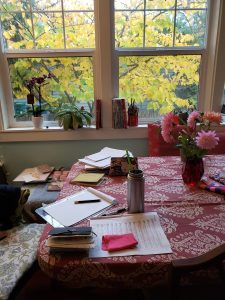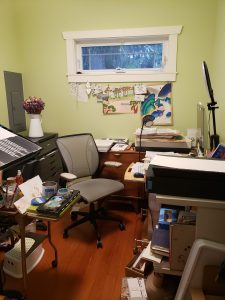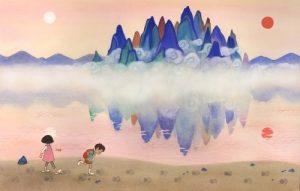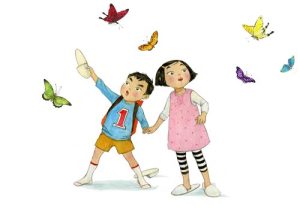Biblio Lotus Team member Megan H. is excited to introduce you to author and illustrator Julie Kim.
On her website in a section titled "Who Is This Person," Julie Kim, author and illustrator of Where's Halmoni and Where's Joon, says:
In case you were curious... I am a quiet non-single with two wonderful kids living in the great Northwest. I love the outdoors but mostly stay indoors, rain or shine. Beautiful colors make me very happy, but so do rain drops on a gray day. I used to be the sensitive creative type but my middle-age has turned me into a no-nonsense Korean-American ahjumma. Fortunately, I still enjoy telling little stories with lots of big pictures.
A graduate of Rhode Island School of Design, I’ve published picture books and have illustrated for magazines, educational/child developmental literature, and cool non-profit organizations.
Aiyah. Self-promotion is so hard.
Can you please describe your art process? Does the text come first or the illustrations? What’s your work routine to finish a book?
Once I have a general idea of the book in my mind, I use words for writing down the basic plot of the story, and use images to take notes on how I see the story or key parts in my mind. So often, words and images happen at once, supporting each other from the very beginning.
Once I have the basic plot points, I make thumbnail sketches of the entire story. This allows me to figure out when and where story arcs happen so that everything flows smoothly. After this, I make a bigger book dummy to work in finer detail of the different scenes, focusing on composition, text and story flow. I go over and edit the story out many many times before submitting the book dummy to my publisher. When I get green light from the editor after they look it over, then I will start on the final painted art. This is where I finalize the composition of the image and decide on the color palette. My sketches tend to be on the rougher side as I like to save my energy for the final art so it feels alive and spontaneous when I am done with it. If I overwork the sketches and just copy them into final art, I notice that the final product can feel wooden and stiff.
Who are some of your favorite children’s book illustrators?
I really appreciate Heena Baek, a Korean author/illustrator, Sydney Smith, and Beatrice Alemagna’s work.
What are some of your favorite children's books?
Some of my favorite children’s books are: Cloud Bread and Sherbet Moon by Heena Baek. I also love I Talk Like a River by Jordan Scott, and Mel Fell by Corey Tabor.
What media do you use for your art? Digital, traditional, or a mix of both? How do these affect your art style?
I work mainly with watercolor and pencil. However, for the sake of saving time, I complete the work on paper up to 90% and finish it digitally, which means that I will make final corrections or adjustments in color and tonal depth in Photoshop. With 120 pages of art, I had to be very efficient with my time. Stylistically, Photoshop is used to enhance the traditional painting method, and not much else. For my work, I like the look and richness of traditional watercolor on paper.
Can you share your journey to becoming a published author/illustrator?
I started out as an illustrator for children’s books, but it didn’t feel very satisfying because I wasn’t really getting the stories that I wanted to work on. After I had my daughter, I realized that I wanted to write as well. I wanted to tell stories, both in words and pictures. As member of SCBWI (Society of Children’s Book Writers and Illustrators), I attended many conferences to learn about writing and publishing. I worked on several different story ideas, but Where’s Halmoni? was the story that felt like everything came into place. I really worked hard on polishing the story with my critique group (other writers and illustrators) and when I submitted the book dummy to Sasquatch Books, it was accepted.
It was wonderful to see the characters playing Ga-wi, Ba-wi-Bo 가위 바위 보 (rock, paper, scissors). Korean school kids use this so much to settle conflict. I’ve also seen adults use it some time for fun. Did you play Ga-wi, Ba-wi-Bo a lot as a child?
Of course! I used to play this with my brother to pass the time, or to see which one of us would get the extra cookie, or do a chore neither of us wanted to do.
What inspired you to write “Where’s Halmoni?” and “Where’s Joon?”? Is there a personal story there? Did you see a gap in published children’s books that you wanted to fill?
I wanted to write about the strange place of belonging and not-belonging that I experienced as a Korean-American. By having two different cultures, it feels like I don’t entirely belong to either cultures. This can feel like alienation, depending on the perspective. I personally feel that it is a boon, a blessing, to have more than one cultural identity. However, it can be used by others to make me feel like an outsider, and I wanted to explore this in the book in a positive way. Despite the language barrier, Jin (Noona) and Joon fearlessly enter and navigate this strange world of their Korean heritage. Their American-ness and Korean-ness is a positive thing in that neither world is completely unfamiliar. They have the keys to enter both worlds and have the opportunity to expand their world view and who they are as individuals.
In “Where’s Halmoni?” and “Where’s Joon?”, Halmoni 할머니, Joon 준, and Jin 진 (aka “Noona” 누나) dialogue is mostly in English with some Korean words spelled out phonetically with Roman letters? Why did you use the Roman alphabet for when these three character’s speak Korean instead of using hangul 한글(the Korean phonetic alphabet)?
I find that language is a very porous thing. One language bleeds into the other due to our exposure to different world cultures. In modern Korean vocabulary, one sees a lot of English words written and spoken in phonetic Korean. Sometimes it is because there is no Korean equivalent for the word, or, it is marketing its ‘foreignness’. Likewise, words like “halmoni” and “noona” are titles/names that Jin and Joon have inherited as English speakers. These words are Korean words, but as English speakers, Jin and Joon have absorbed them into their English lexicon and use them as such.
The characters from the Korean folktale world, such as Tokki 토끼 (rabbit), Horangi 호랑이 (tiger), and the Dokkebi 도깨비 (goblins) speak in Korean using hangul 한글. Later in the books is a section translating what they said to English. Why did you choose to have the translation at the end of the books instead of next to the Korean?
It was important to have the reader experience the discomfort of not knowing what the Korean folktale character is saying, because that is essentially what Jin and Joon are experiencing. It is completely okay to not know because Jin and Joon still figure it out. To have the translations right on the page would interfere with the story and make it less effective. And it’s a treat to go to the translations to learn what all the characters were saying because now your understanding of the story has suddenly expanded and you get in all the jokes.
What is your favorite Korean folktale?
I really enjoyed the stories of Miserly Jarin-gobi for their humor, and the Red Bean Soup Halmoni (팥죽 할머니) for its empowering message. However, much of my motivation to write Where’s Halmoni? and Where’s Joon? was to update all the old folktales that I found deeply unsatisfying. The biggest one is Haenim Dalnim. The version I grew up with is much more gruesome and I found the ending to be depressing and demoralizing. A tiger is a fearsome creature, often symbolizing extreme greed and power of the old upper class Korean society. How do we want to confront that in our present modern society? Do we wait for a heavenly rope to save us, or do we find it in ourselves to confront our modern day tiger straight-on?






